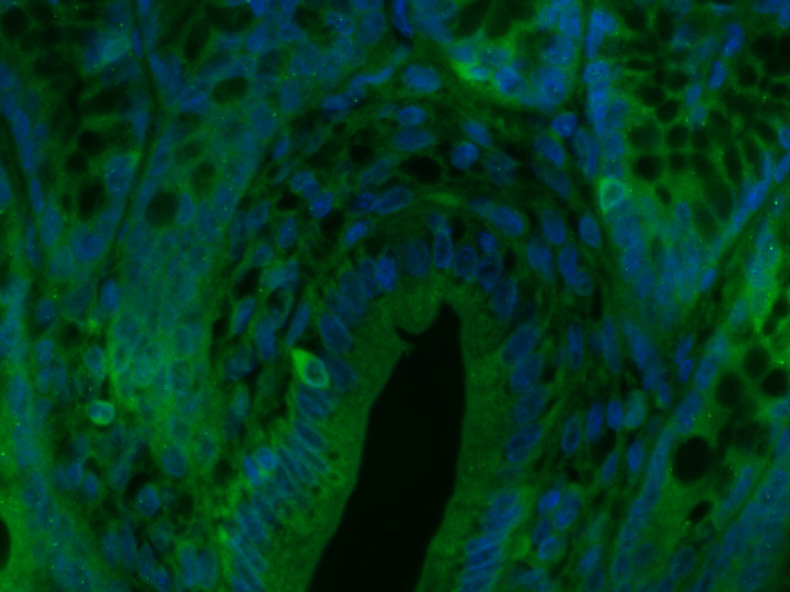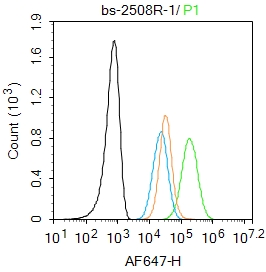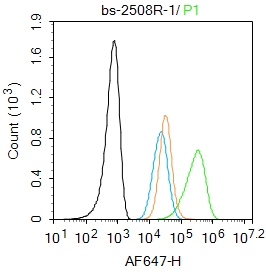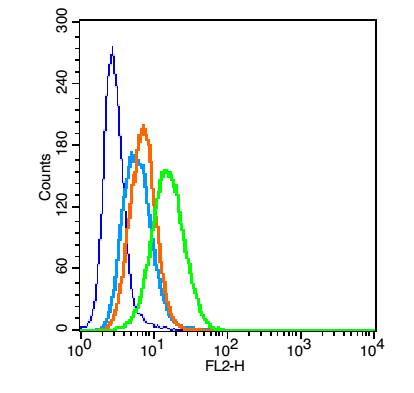
Rabbit Anti-CD11c antibody
Integrin alpha-X; integrin alpha-X precursor; ITGAX; SLEB6; CD11C (p150) alpha polypeptide; complement receptor 4; integrin aX; CD11 antigen-like family member C; leukocyte adhesion receptor p150,95; leukocyte adhesion glycoprotein p150,95 alpha chain; IT
View History [Clear]
Details
Product Name CD11c Chinese Name 整合素αX抗体 Alias Integrin alpha-X; integrin alpha-X precursor; ITGAX; SLEB6; CD11C (p150) alpha polypeptide; complement receptor 4; integrin aX; CD11 antigen-like family member C; leukocyte adhesion receptor p150,95; leukocyte adhesion glycoprotein p150,95 alpha chain; ITAX_HUMAN. literatures Research Area Cell biology immunology Signal transduction Stem cells Cell adhesion molecule Immunogen Species Rabbit Clonality Polyclonal React Species Human, Rat, (predicted: Mouse, Dog, ) Applications ELISA=1:5000-10000 Flow-Cyt=1μg/Test IF=1:200-800
not yet tested in other applications.
optimal dilutions/concentrations should be determined by the end user.Theoretical molecular weight 126kDa Detection molecular weight 145-150 kDa Cellular localization The cell membrane Form Liquid Concentration 1mg/ml immunogen KLH conjugated synthetic peptide derived from human Integrin Alpha X: 501-600/1163 Lsotype IgG Purification affinity purified by Protein A Buffer Solution 0.01M TBS(pH7.4) with 1% BSA, 0.03% Proclin300 and 50% Glycerol. Storage Shipped at 4℃. Store at -20 °C for one year. Avoid repeated freeze/thaw cycles. Attention This product as supplied is intended for research use only, not for use in human, therapeutic or diagnostic applications. PubMed PubMed Product Detail This gene encodes the integrin alpha X chain protein. Integrins are heterodimeric integral membrane proteins composed of an alpha chain and a beta chain. This protein combines with the beta 2 chain (ITGB2) to form a leukocyte-specific integrin referred to as inactivated-C3b (iC3b) receptor 4 (CR4). The alpha X beta 2 complex seems to overlap the properties of the alpha M beta 2 integrin in the adherence of neutrophils and monocytes to stimulated endothelium cells, and in the phagocytosis of complement coated particles. [provided by RefSeq].
Function:
Integrin alpha-X/beta-2 is a receptor for fibrinogen. It recognizes the sequence G-P-R in fibrinogen. It mediates cell-cell interaction during inflammatory responses. It is especially important in monocyte adhesion and chemotaxis.
Subcellular Location:
Membrane.
Tissue Specificity:
Predominantly expressed in monocytes and granulocytes.
Similarity:
Belongs to the integrin alpha chain family. Contains 7 FG-GAP repeats. Contains 1 VWFA domain.
SWISS:
P20702
Gene ID:
3687
Database links:Entrez Gene: 3687 Human
Entrez Gene: 16411 Mouse
Omim: 151510 Human
SwissProt: P20702 Human
SwissProt: Q9QXH4 Mouse
Unigene: 248472 Human
Unigene: 22378 Mouse
Product Picture
Primary Antibody (green line): Rabbit Anti-CD11c antibody (SL2508R)
Dilution: 1μg /10^6 cells;
Isotype Control Antibody (orange line): Rabbit IgG .
Secondary Antibody : Goat anti-rabbit IgG-AF647
Dilution: 1μg /test.
Protocol
The cells were incubated in 5%BSA to block non-specific protein-protein interactions for 30 min at room temperature .Cells stained with Primary Antibody for 30 min at room temperature. The secondary antibody used for 40 min at room temperature. Acquisition of 20,000 events was performed.Blank control: Raw264.7.
Primary Antibody (green line): Rabbit Anti-CD11c antibody (SL2508R)
Dilution: 1μg /10^6 cells;
Isotype Control Antibody (orange line): Rabbit IgG .
Secondary Antibody : Goat anti-rabbit IgG-AF647
Dilution: 1μg /test.
Protocol
The cells were incubated in 5%BSA to block non-specific protein-protein interactions for 30 min at room temperature .Cells stained with Primary Antibody for 30 min at room temperature. The secondary antibody used for 40 min at room temperature. Acquisition of 20,000 events was performed.Blank control (blue): U937 cells(fixed with 2% paraformaldehyde (10 min)).
Primary Antibody:Rabbit Anti-CD11c antibody(SL2508R), Dilution: 1μg in 100 μL 1X PBS containing 0.5% BSA;
Isotype Control Antibody: Rabbit IgG(orange) used under the same conditions );
Secondary Antibody: Goat anti-rabbit IgG-PE(white blue), Dilution: 1:200 in 1 X PBS containing 0.5% BSA.
References (0)
No References
Bought notes(bought amounts latest0)
No one bought this product
User Comment(Total0User Comment Num)
- No comment






 +86 571 56623320
+86 571 56623320
 +86 18668110335
+86 18668110335

